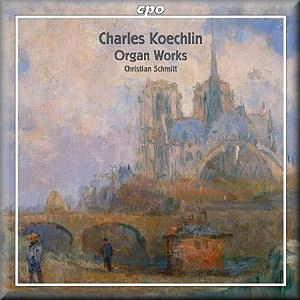 |
 |
|


alternatively
CD: MDT
AmazonUK
AmazonUS
Sound
Samples & Downloads |
Charles KOECHLIN
(1867-1950)
Choral in F minor, Op. 90b (1924) [5:53]
Deux Vocalises, Op. 212b (1947) [9:03]
Choral Final du Requiem, Op. 161 (1937) [3:52]
Sonatine III, Op. 107 (1929) [3:43]
Quatre Chorals, Op. 98 [10:21]
Pièce pour orgue, Op. 226 [3:53]
Fugue, Op. 133 no 2 [6:40]
Adagio, Op. 201 [7:47]
Sonatine II, Op. 107 (1929) [8:06]
Adagio, Op. 211 (1947) [3:31]
Sonatine I, Op. 107 (1929) [4:48]
Fugue modale Op. 240b [3:30]
 Christian Schmitt (organ)
Christian Schmitt (organ)
rec. 27-28 June 2009, Marktkirche Hannover
 CPO 777 512-2
CPO 777 512-2  [67:40]
[67:40] 
|
|
|
I’ve been aware of Charles Koechlin for a very long time,
having played flute pieces of his for almost as long as I can
remember. It’s only relatively recently however that his
name seems to have been cropping up more in the CD catalogues,
with fascinating and remarkable works such as the piano cycle
Les Heures Persanes showing previously little known aspects
of the composer. Organist Christian Schmitt has here recorded
a representative sample of organ works by Koechlin, and as many
of these are première recordings this disc will add considerably
to our supply of Koechlinalea.
Koechlin himself was more of a pianist than an organist, and
the conventional nature of earlier works such as the Choral
in F minor develops into further extremes of contrapuntal
extremity as evidenced by the later opus numbered Choral Final
du Requiem, which pushes canonic techniques into a labyrinthine
elegy. If you like Hindemith’s organ sonatas, then the
three Sonatines which Koechlin wrote during 1928-29 occupy
comparable melodic and harmonic territory. Koechlin’s
fascination and deep study of Bach comes through strongly in
the Finale of Sonatine III, and the first and
second of these pieces contrast with the rest of the programme
in also having lighter Pastorale movements. There is
also a good deal of melodic charm in the Quatre Chorals,
produced as a by-product of the composer’s own composition
classes.
This programme contains what is apparently Koechlin’s
last work, the eccentric Pièce pour orgue, Op. 226,
which shows the composer exploring the essence of his own expressive
palette in what the booklet notes describe as “sketchy
textures.” More monumental is the extended Fugue Op.133
II originally written for “a symphonic string apparatus”,
and with seemingly impossible chromatic lines. More gentle and
improvisatory is the Adagio pour Grand-orgue Op.201,
which nonetheless builds a remarkable structure in which one
can become totally immersed.
The recently rebuilt 1950s Marktkirche organ is a tremendous
instrument, and very well suited to this music. A more nasal
French sound might arguably be more appropriate, but whether
consciously or not the organ sound here points to the universality
of Koechlin’s expressive world and to my ears is both
appropriate and highly enjoyable. The CPO recording is very
rich and deep even in plain stereo. As an SACD multi-channel
experience it really is of demonstration quality. This is one
of those inspiring releases which anyone keen on organ music
and 20th century repertoire should have around. The
organ music of Charles Koechlin should hold no fears for anyone
attracted by the romantic worlds of Widor and Duruflé,
and indeed it often harks back to more ancient worlds in its
sometimes antique style and use of the models of Bach. This
organ sound is woodsmoke and nostalgia to me, and has restored
my faith in its qualities as a truly expressive instrument.
Superbly performed and produced with useful booklet notes, it
is one of the nicest organ recordings I’ve heard for a
long time.
Dominy Clements
|
|

